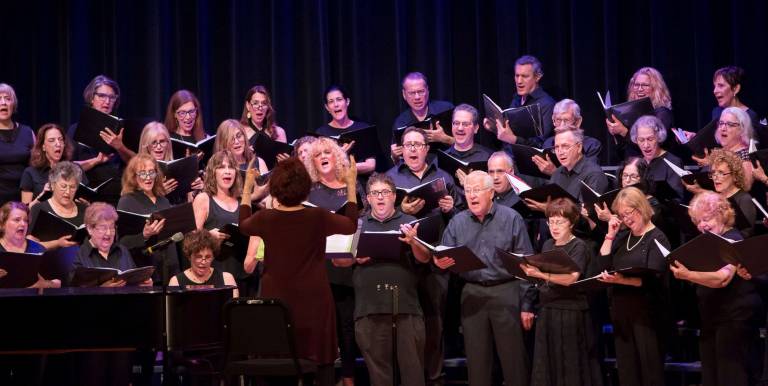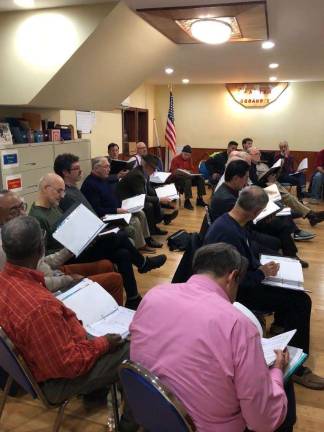Song and the city


The more than 200 ensembles in Manhattan ensure that choral culture thrives
BY SHOSHY CIMENT
Monday evenings are usually quiet on The Upper West Side. Unless, that is, you happen to be near the Broadway Spanish Church at 93rd Street and Amsterdam Avenue. And if you are, you will likely hear the voices of about 30 men radiate from the church’s basement windows to the otherwise still streets. They are the collective sound of the Mendelssohn Glee Club, the oldest men’s chorus in America.
For a singer hungry for performing, New York City is a smorgasbord. There are 222 active choirs and vocal ensembles peppering the Manhattan landscape, according to a choir directory run by Vocal Area Network, which catalogues and publicizes vocal ensemble concerts, auditions and general information. And that’s not counting the church-based choirs.
“Singing in New York is the greatest,” remarked Jack Willoughby, a seasoned baritone in the Mendelssohn Glee Club who has previously sung with the New York Choral Society and the Collegiate Chorale, now known as MasterVoices.
To this day, the Mendelssohn Glee Club performs in white ties and tails to audiences that have since shed their tuxedos and gloves but have retained their fascination with this New York musical tradition.
“If you take a male chorus, they’re kind of earthy sounding,” said Gene Wisoff, the club’s director for the past 25 years. “A treble choir is different.” In four parts - tenor, second tenor, baritone and bass - the group performs a variety of traditional pieces.
Other than possessing an appreciation for quality singing, the group is an eclectic mix. Singers include journalists, lawyers, students, doctors, dentists and engineers, some of them retired. Age-wise, the group runs the gamut as well; there are men with brown hair, men with white hair, and men with no hair at all.
But what once was regarded as a highfalutin, Upper Manhattan social club has somewhat declined in status since its founding in 1866. Entry to the club is not nearly as competitive as it once was; most current members were brought into the club by their friends.
“We’ve come down a bit in the world but maybe for the better,” said Ben Rinzler, a bass singer and treasurer of the club. “It’s become more democratic.”
For the Mendelssohn Glee Club, remaining a sentimental anchor in the ever-evolving New York choral landscape is a defining feature. Other choral groups, however, occupy different niches. The Jewish People’s Philharmonic Chorus, founded in 1922, has a repertoire composed entirely of Yiddish songs while the Lance Hayward Singers have been performing predominantly jazz-oriented arrangements since 1984.
In another vein, the Broadway at 92Y Chorus, an arm of the 92Y School of Music, describes itself as the only ensemble in New York devoted to performing songs exclusively from the American musical theater songbook, boasting a sing-along portion in many of its concerts.
“To sing and conduct this style of music is like riding a huge energy wave,” said Yana Stotland, the director of the 92Y School of Music. “There’s musically nothing like it!”
Evidently, for many New York musicians, sticking to the oldies doesn’t quite cut it.
Rejecting any restrictive form of old-school ensemble singing, conductor Vince Peterson took choral performance to the next level when he founded Choral Chameleon in 2008.
“I discovered that there is a fair amount of elitism out there,” said Peterson, a graduate of the Mannes School of Music who was saddened by what he saw as a tendency to reject “vernacular” music of the world as substantial musical compositions.
“A composer from 500 years ago might be saying the same fundamental thing about life and living as a pop music composer of today,” he reasoned. Hungry for new, meaningful music, Peterson began experimenting with genre-blending and performance-infused work, neglecting the one-sided nature of traditional choral showcase.
With 12 members in its original ensemble, Choral Chameleon pushes the limits of musical experience for its singers and audiences. In its performances, the group has incorporated body movement, aspects of traditional Japanese puppet theater, shadow puppetry and food.
In addition to its regular showcases, Choral Chameleon is the vocal ensemble-in-residence at National Sawdust, a new music venue in the city. The group also runs a yearly institute, an eight-day Brooklyn-based think tank where composers and conductors from all over the world flock to study and experiment with new music, using Choral Chameleon as a lab choir.
For Peterson, making meaningful art is his impetus to conduct. “It is very much an act of humility,” said Peterson. “It’s not about me.”
While styles and genres evolve over time, the thrill of making music appears to be everlasting. For Wisoff of the historic Mendelssohn Glee Club, the feeling is no different. “There’s a lot of satisfaction in this,” he said. “And it’s a lot of fun!”